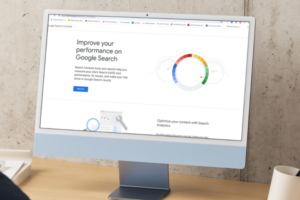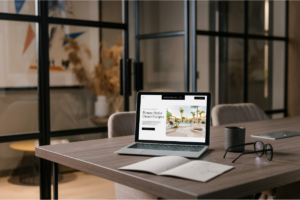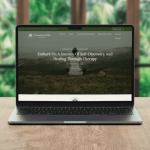the entrepreneurs practical guide to grow a service business
The Perils of Outdated Web Design and Why It’s Time for an Upgrade
Don't let outdated web design hold your business back from landing your ideal clients.

How an Outdated Website Can Cost You Clients—and What to Do About It
Picture this: you walk into a restaurant that has seen better days—faded paint, outdated menus, and flickering lights. You’d likely turn around and look for a more inviting spot, right? Your website functions in the same way. For service-based businesses in Chandler, AZ, an outdated web design can scare potential clients away faster than you can say “website.” Let’s explore why upgrading your site is crucial and how to approach this transformation.
the impact of outdated web design
Your website is often the first impression potential clients get of your business. If that impression is negative, they may never return. Here’s why an outdated design can be a significant hurdle:
First Impressions Matter: Studies show that users form an opinion about a website in just 50 milliseconds. An outdated design can signal that your business is unprofessional or out of touch with modern standards.
Poor User Experience: Older websites tend to have clunky navigation, slow loading times, and non-responsive designs. If users can’t easily find what they need, they will likely bounce to a competitor’s site that offers a smoother experience.
Lack of Mobile Optimization: With over half of all web traffic coming from mobile devices, a website that isn’t mobile-friendly can deter potential customers. If visitors have to pinch and zoom to navigate your site, it’s time for an upgrade.
Identifying Signs Your Website Needs an Upgrade
So how do you know it’s time for a redesign? Look out for these telltale signs:
High Bounce Rates: If visitors leave your site quickly, it’s a clear indicator they’re not finding what they need. Use analytics to identify pages with high bounce rates and consider redesigning those.
Outdated Branding: If your website no longer reflects your current branding or messaging, it’s time for an update. A cohesive brand identity is essential for building trust with your audience.
Content Issues: Stale or irrelevant content can make your site feel neglected. Regularly updated content keeps your audience engaged and improves your SEO.
An outdated website can drive potential clients away.
The Benefits of a Modern Website
Investing in a redesign offers numerous benefits that can significantly enhance your business:
Enhanced User Experience: A modern design prioritizes user experience (UX). Improved navigation, faster loading times, and mobile optimization keep users engaged and decrease bounce rates.
Increased Conversions: With clear calls to action (CTAs), lead generation forms, and appealing visuals, a new website can significantly boost your conversion rates. After all, attracting visitors is just the beginning; turning them into clients is the goal.
Stronger SEO Performance: An updated website is more likely to follow SEO best practices, improving your search engine rankings. Incorporating local keywords, like “web design in Chandler,” helps attract the right audience.
Steps to Redesigning a Website:
Ready to take the plunge? Here’s a roadmap for a successful website redesign:
Set Clear Goals: Define what you want to achieve with the redesign. Whether increasing leads, improving SEO, or enhancing user experience, having clear objectives will guide your design choices.
Research Competitors: Look at your competitors’ websites. Identify what works and what doesn’t. Use this information to inform your own design strategy.
Choose a Design Style: Decide on a design style that resonates with your brand. Whether minimalist, vibrant, or professional, your style should reflect your business personality.
Develop a Content Strategy: Create a plan for updating your content. Ensure it’s engaging, relevant, and optimized for both users and search engines. Consider incorporating blog posts that address common questions in your industry.
Test and Optimize: Before launching, thoroughly test your site for any bugs or issues. Ensure it looks good on various devices and browsers. Post-launch, monitor performance and make adjustments as needed.
The design process and what to expect
Understanding the design process can help set realistic expectations. Here’s a breakdown of what typically happens during a redesign:
Initial Consultation: This is where you discuss your vision with your designer. Outline your goals, design preferences, and any specific features you want to include.
Design + Development Phase: After the designs are approved, the site goes into development. This is where the technical magic happens—coding, integrating features, and ensuring the site is functional.
Testing: Before the site goes live, it will undergo rigorous testing to ensure everything works as intended. This includes checking links, forms, and overall functionality across devices.
Launch: Once testing is complete, it’s time for the big reveal! Your new site goes live, and you can start reaping the benefits of your investment.
post-launch strategies
After your new site is live, consider the following strategies to maximize its impact:
Promote Your New Site: Use social media, email newsletters, and other channels to announce your new website. Engage your audience by highlighting key features or content.
Monitor Analytics: Keep an eye on your site’s performance metrics. Are you seeing lower bounce rates and higher engagement? Use tools like Google Analytics to track these changes.
Regular Updates: Continue to update your content and design as needed. Regularly refresh your blog and other site areas to keep your audience engaged and improve SEO.
Conclusion: Don’t Let Your Website Hold You Back
Your website is a vital tool for attracting and retaining clients. An outdated design can not only drive potential clients away but also hinder your business growth. By recognizing the need for an upgrade and taking proactive steps to modernize your site, you’ll position your business for success.
Is it time to give your website a fresh new look? Embrace the change, and watch your client base grow!

hey, im sam!
I’ve helped dozens of business owners grow their online presence through powerful, converting websites and brand design. Will you be next?
search by category
related posts

What is Google Search Console?
Learn how Google Search Console helps your website rank in Google Search Results. An invaluable free tool at your disposal.

2025 Website Trends: What You Need to Know to Stay Ahead
The world of web design is constantly evolving, and with 2025 fast approaching, it’s time to get ahead of the curve.

What is NAP and why is it important?
Learn how outdated and accurate NAP (Name-Address-Phone Number) will affect your local SEO visibility









